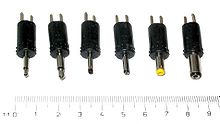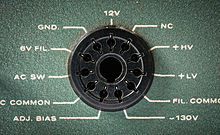DC connector
Compared to domestic AC power plugs and sockets, DC connectors have many more standard types that are not interchangeable.
The dimensions and arrangement of DC connectors can be chosen to prevent accidental interconnection of incompatible sources and loads.
These plugs are intended for use on the cable connected to an external AC adapter (power supply).
If the size is not known, it is difficult to distinguish by eye or measurement between the 2.1mm and 2.5mm ID plugs; some suppliers suggest simple methods.
The 'tip' (i.e., the inner conductor) usually carries the positive (+) pole, but some devices and their power supplies use the negative tip.
This style of terminal is principally designed as a precision-machined pin for insertion into connector bodies.
[6] The International Electrotechnical Commission (IEC) has produced a standard for a system of 2-pin plugs and socket-outlets for household and similar purposes in fixed and portable applications, either indoors or outdoors.
Safety extra-low voltage (SELV) plugs and socket-outlets carry up to 16 amperes, and have eight keying possibilities, to indicate 6, 12, 24, or 48 volts, AC or DC.
The dimensions are as follows:[7] The male shield has two keys projecting inwards, which fit into notches in the female body.
Tamiya connectors are commonly used on radio control (toy) vehicle battery packs and chargers.
[9] The Deans style T-Plug connector is a polarized high power plug that inhibits accidental reversed connections.
These are designed to pass very high currents at voltages up to 600 V DC to and from battery packs, inverters, and other high-current loads to a terminal bus.
Most other airlines that provide DC power use the smaller EmPower system, which has a 4-pin Hypertronics' D-series connector.
Powerpole connectors are a series developed by Anderson Power Products[10] and available in a variety of sizes and colors.
The commonly used 15/30/45 series connectors are interoperable and use the same housings but different contacts for different wire sizes and current requirements.
Powerpole connectors are physically and electrically genderless, thus avoiding the need to worry about which end is the plug and which the socket, or which end has the correct polarity, as is the case with the physically but not electrically genderless two-wire trailer plug.
However, they can be damaged relatively quickly and, if not correctly crimped, can occasionally separate from each other easily with minimal force unless additional retaining measures are taken.
Conversely, the positive terminal on a battery charger is exposed to mate with the concealed one on the vehicle side.
On the other hand, the short-circuit current of the lead–acid batteries installed in vehicles is sufficiently great that a short circuit could result in a fire or explosion.
[citation needed] Because of this, and the small gauge wire sometimes used, they may provide unreliable power connections.
[citation needed] The polarity for 12 VDC sockets is center pin positive (+), outer collar negative (−).
[10] The possible range of battery voltages from 11–15 VDC must be taken into account by devices attached to the cigar lighter socket.
[citation needed] Similar in concept to an automotive cigar lighter, the ISO 4165 connector is shorter and smaller.
Found most frequently on motorcycles, it is also known as a "BMW Accessory", "Hella", "Merit", "Norm"[citation needed] or "Powerlet" connector.
[13] In the European Union, the Radio Equipment Directive 2021/0291, requires new smartphones to use USB-C as a universal charger by the end of 2024, and laptops by 2026.
Because these panels are exposed to the weather for decades, MC4 includes a rubber sealing ring to keep out moisture.
Because solar panels are often stacked in strings of hundreds of volts, MC4 has locking clips to hold the wires together.
Because solar panels can be connected in series strings, or parallel arrays, the positive and negative terminals use separate connectors.
The M12 F-coding is rated for 300 V. The IEC TS 62735 standard[18] specifies connectors capable of carrying between 294 and 400 VDC.
This style of connector is often seen on high voltage test equipment, such as power supplies and volt meters capable of handling 10 kV and above.






















